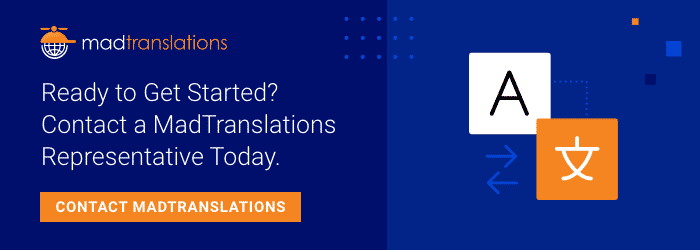The question “should my company insource or outsource translation?” is timeless. Buyers of language services continually weigh the “right” answer. Like many other industries, demand for services in the language industry fluctuates between lean corporate years—when translation buyers have limited budgets to bring on staff to handle translation projects—and the years where revenue allows for more insourcing. However, the truth is, there is no “right” answer. It all depends on your company, its capabilities, and its needs.
Outsourcing Works for Most
The reason why most translation buyers choose to outsource is the intermittent need for translation. Having translators in-house that you can only keep busy for a few months a year is not worth the cost. The commercial translation marketplace is built to support the production of projects and has rationalized the supply chain so that it’s cost-effective and time-efficient.
Depending on where your company is doing business or how the list of target markets may change, you may need to support more or fewer languages depending on your product and where it is going to be sold. Having a flexible supply chain is critical. That is a challenge if you choose to insource translation.
However, who says you must hire the translators? The truth is that most translation service companies contract with individual translators. Why can’t your company do the same thing? Of course it can, but here is what you should consider:
- What type of translation process do I need? Can a lone translator do the work or do I need an editor to support the translator? Do I need multiple teams of translators to support different content types?
- How many languages do I need to support? Finding a single translator for a small one-off project is not difficult but finding 10 translators and 10 editors for a larger project is considerably more work.
- What infrastructure do I need to translate? If your project requires multiple translators, how will they work together and how will they be able to ensure a consistent, reliable product?
- How will you manage quality and measure performance? If you don’t know the target language(s), how will you know if your translators are doing a good job?
- Once the translation is done, how will I maintain the translated documents going forward?
- How do I know how much all this is going to cost?
- Do I have time to do all this? Do I need to hire a translation project manager?
You begin to see the value that translation service companies offer. They do all the above. The best translation companies do even more, such as:
- Source qualified translation talent, who have extensive experience in your subject matter.
- Provide reliable translation processes, tools, and management infrastructure.
- Retain meticulous records about your project so that they can easily handle updates.
- Provide accurate pricing and turnaround prior to starting your project.
Insourcing Translation Might be the Right Fit
Despite these benefits, insourcing may still make more sense for your company. Here are the top five reasons that drive insourcing of translation:
- Complex products or process
- Persistent need
- Broader need for linguistic talent
- A limited list of target languages
- Proprietary content
Tools and Complexity
A complex process may arise because of your company’s toolset. For example, if your company makes software products your development process may be more efficient with a linguist/programmer on staff. Some types of software are so specialized and complex that it is far easier to have the translator who will translate the user interface sitting right next to the developers so that they can ask questions and request changes to the software in real-time.
Persistent Need
The pivotal factor for deciding between insourcing vs. outsourcing is the level of need. If your company only needs to translate documents a few times per year, then keeping translators on staff makes little sense. Taking on the administrative cost of sourcing and managing your own team of translators is also prohibitive for a handful of engagements per year.
Assuming that content is created on an ongoing basis and requires translation, having staff translators may make sense. A good rule of thumb is to assess whether the cost of translation per language will exceed the salary and benefits of a single full-time translator for that language. For example, a translator earning $75,000 per year costs your company approximately $40/hour. There are few translation companies that can match that hourly rate for translation.
Obviously, there are other costs to hiring an in-house translator, typical of hiring any staff: equipment, furniture, supplies, etc. A translator may need more specialized software, such as translation memory tools and subscriptions to other online resources such as dictionaries and machine translation engines. You need to factor in these costs as well. These costs can easily be avoided if you work with a contract translator or translation company.
A Broader Need
Having multilingual staff brings other benefits besides translation (Note: not all multilingual people are effective translators). Multilingual staff can help with marketing, product development, international customer support, among other activities. If your company has other needs besides translation, then this can help build the business case to hiring in-house linguists or reviewers.
Limited List of Languages
If your organization supports the same list of geographic or language markets and there is sufficient ongoing need, then insourcing could work for you. However, if the list of languages you support may change based on market conditions, then outsourcing to a multilanguage vendor (“MLV”) will make more sense. MLVs are experts at supporting multiple languages and can support changes in language scope. They also have more capability to scale for large versus small projects. The greatest benefit of working with a translation company is that they also take on all the project management responsibilities. This effort is often underestimated by those who have not managed large multilingual projects. The headaches that are often involved in project management will no longer be yours.
Proprietary Content
If your company is active in the defense industry or deals with sensitive intellectual property, then having in-house staff may be your company’s only option. For example, for defense contractors, it may be a requirement that all individuals who work for the U.S. government be citizens of the U.S. Individuals with the requisite language and technical skills will be difficult to find and even harder for a translation service company to engage on contract. Your company will have more success hiring such talent.
Can a Single Freelancer Get the Job Done?
It may be possible to avoid hiring altogether. Contracting with a single translator may be the most cost-effective option. Consider, however…
- Will a single translator be able to handle all the work?
- Does that individual have all the necessary skills to provide a publishable translation?
- Is single-pass translation (translation with no editorial and proofing support) sufficient for the quality that you need?
- Is it safe to single thread your translation process?
- How much management will the freelancer require?
- How will maintenance be managed?
As this post demonstrates, insourcing vs. outsourcing translation is a complex decision that will require a high level of commitment from corporate leadership and, therefore, will require a robust analysis of the costs and benefits. If your organization is wrestling with this decision or is evaluating how it currently handles translations, you can reach out to MadTranslations for an objective evaluation.











